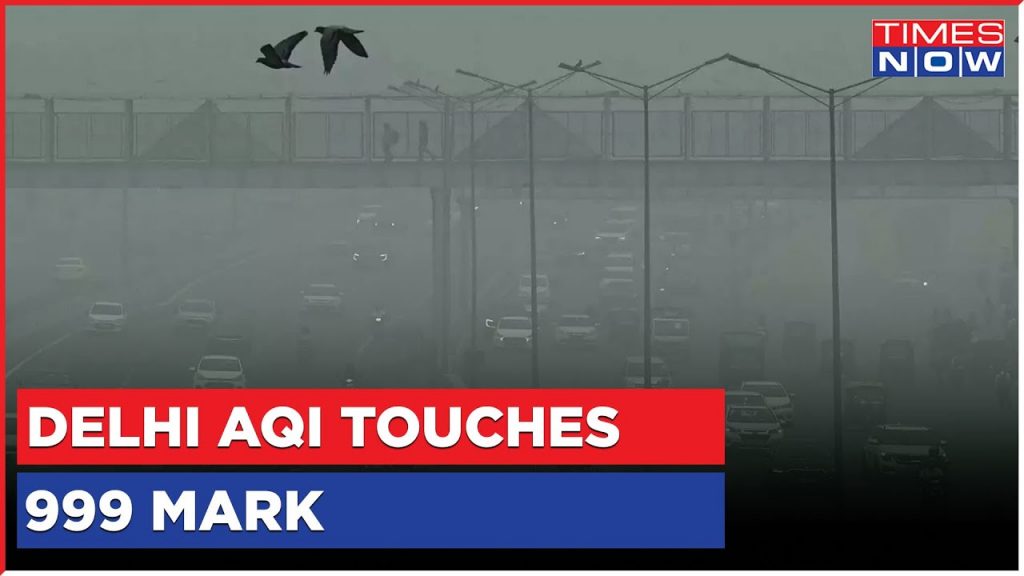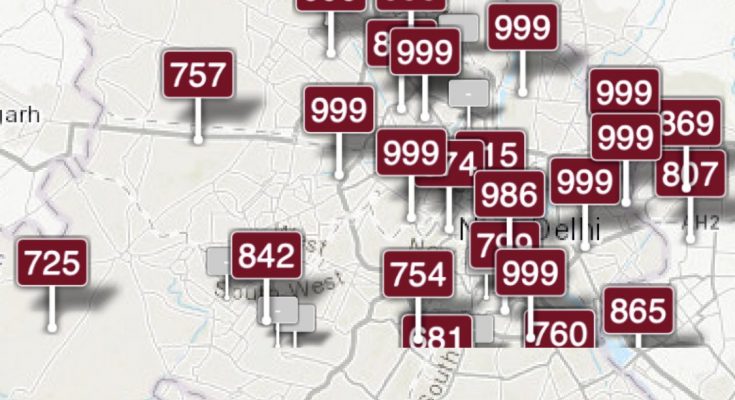This essay delves into Delhi’s air pollution, focusing on its severe impact, key pollutants, and the adverse health effects on residents. It explores the root causes, including rapid urbanisation, traffic, industrial activities, and stubble burning, and discusses multifaceted efforts to combat the smog, from government policies to community initiatives. Drawing lessons from global cities, it underscores the need for collective action and innovative solutions to ensure a healthier future for Delhi.
Essay on Air Pollution in Delhi – 1400 words
Delhi’s Air Crisis- Health Hazards and Hopes for Clear Skies
“Dilli hai dil walon ki” – Delhi, the city of the heartful, stands veiled under a cloak of smog, challenging its vibrant essence. On the 3rd of November 2019, Delhi faced an unprecedented environmental crisis, marking the most polluted day in global history with many areas reaching AQI levels of 999, beyond the measuring capacity of metres, signalling a disaster. As India’s capital, Delhi epitomises both historical splendour and rapid modernization, yet it is also at the forefront of urban air pollution. This essay explores the smog-filled atmosphere of Delhi, highlighting not just the severe air quality issues but also the intertwined complexities of urban growth, public health, and the pursuit of sustainable environmental solutions.
The Air We Breathe in Delhi
Present Condition
Delhi’s air quality often oscillates between “poor” to “severe” on the Air Quality Index (AQI), with numbers soaring above 300 on many days, especially during the winter months. The Central Pollution Control Board (CPCB), which monitors air quality across India, regularly publishes data indicating these levels, underscoring the severity of the situation. For instance, in November, AQI readings frequently peak, coinciding with colder temperatures and increased pollution from various sources.
Key Pollutants and Sources
The air in Delhi is laden with various pollutants, but PM2.5 and PM10 particles are the primary culprits. These tiny particles, much smaller than the width of a human hair, can penetrate deep into the lungs and even enter the bloodstream. Alongside these particulates, nitrogen oxides (NOx) and carbon monoxide (CO) are significant pollutants, primarily emitted from vehicle exhausts, industrial activities, and, notably, the burning of crop residue in the neighbouring states of Punjab and Haryana. This agricultural practice, known as stubble burning, sends waves of smoke towards Delhi, exacerbating the city’s air quality woes during the post-harvest season.
Impact on Health
The health implications of such polluted air are dire. Studies and health reports have highlighted a worrying increase in respiratory ailments, such as asthma and chronic bronchitis, among Delhi’s populace. The long-term exposure to polluted air doesn’t just stop at respiratory issues; it extends to more severe cardiovascular problems, putting an additional strain on the city’s health infrastructure. The impact is particularly pronounced among vulnerable groups, including children, the elderly, and those with pre-existing health conditions, making air pollution not just an environmental issue but a significant public health crisis.
Tracing the Roots of Pollution

Urbanization and Traffic
Delhi’s rapid growth into a sprawling urban metropolis comes with a hefty price tag on its air quality. The city’s expansion has been mirrored by an exponential increase in vehicles, with millions now crowding the streets. Data from the Delhi Transport Department highlights this surge, showing that vehicle registrations have skyrocketed, contributing significantly to the city’s pollution woes. Every additional car, bike, or auto-rickshaw not only adds to the traffic but also to the cocktail of pollutants in the air.
Industrial and Construction Contributions
The ring of industrial activity surrounding Delhi acts as a constant source of pollutants. Areas like Ghaziabad and Faridabad, with their dense clusters of manufacturing units, release a myriad of pollutants into the air, from particulate matter to harmful gases. Additionally, Delhi’s skyline, perpetually dotted with cranes and scaffolding, tells a story of relentless construction. This construction activity is not just reshaping the city’s contours but also its air quality, as dust and particulate matter from these sites become unwelcome additions to the urban atmosphere.
Seasonal Catalysts and Stubble Burning
Seasonal Factors
- Delhi’s winters bring a particular set of challenges. The cold weather leads to temperature inversions, a phenomenon where a layer of cool air gets trapped under a layer of warmer air, effectively caging the pollutants close to the ground. This, combined with the reduced wind speeds during the season, means that the smog has nowhere to go, blanketing the city for days, if not weeks.
Stubble Burning Impact
- Come autumn, the fields in neighbouring states like Punjab and Haryana are set ablaze as farmers clear their land of stubble after the harvest. This practice sends vast clouds of smoke drifting towards Delhi, significantly deteriorating its air quality. Satellite imagery from NASA has often captured this annual exodus of smoke, highlighting the scale and impact of stubble burning on Delhi’s pollution levels. Recognizing the gravity of this issue, authorities have introduced measures to tackle it, from offering subsidies for equipment that can dispose of stubble without burning to promoting alternative uses for agricultural residue.
The Battle Against Smog

Government Initiatives
- Policy Measures- In response to the dire air quality, the Indian government has rolled out several policies aimed at curtailing pollution from all fronts. The Graded Response Action Plan (GRAP) stands out, activated in Delhi when pollution levels hit alarming highs, imposing measures ranging from banning diesel generators to halting construction activities. Alongside, the National Clean Air Programme (NCAP) aims for a comprehensive reduction in particulate matter levels across the country, with specific targets for major cities including Delhi.
- Stubble Burning Interventions- To specifically address the issue of stubble burning, the government has introduced a suite of initiatives encouraging the in-situ management of crop residue. This includes financial assistance for farmers to acquire machinery like the Happy Seeder, which allows them to plant wheat without removing the paddy stubble. These efforts are bolstered by legal measures aimed at discouraging the practice of stubble burning, with both state and central government schemes playing pivotal roles.
Also Check – Is there any alternative to stubble burning?
Technological and Innovative Solutions
- General Technologies- Delhi has seen the introduction of several technological solutions to combat air pollution. Notably, smog towers equipped with air purifiers have been set up in key areas of the city, designed to filter out pollutants from the air. While their efficacy is still under evaluation, these towers represent a novel approach to tackling urban air pollution.
- Agricultural Innovations- On the agricultural front, innovative solutions are being explored to prevent stubble burning. One such method is the use of bio-decomposers, which can turn crop residue into compost directly on the fields, enriching the soil and eliminating the need to burn stubble. Pilot projects employing these techniques have shown promising results, offering a glimpse into potential sustainable practices for agricultural waste management.
Community and Individual Actions
- Awareness and Education- Raising awareness about the environmental and health hazards of stubble burning among the farming community is crucial. Educational campaigns and workshops aim to inform farmers about the negative impacts of burning stubble and the availability of sustainable alternatives.
- Collaborative Efforts- There are inspiring examples of community-led initiatives where farmers, NGOs, and local governments have come together to tackle the issue of stubble burning. These collaborations often involve the adoption of alternative practices such as using stubble as fodder, incorporating it into the soil as a natural fertiliser, or even converting it into bioenergy. Success stories from such programs highlight the potential for community action to bring about significant change in reducing air pollution.
The fight against smog in Delhi is multifaceted, involving a mix of policy interventions, technological innovations, and grassroots efforts. Each of these components plays a vital role in the broader strategy to clear the air, underscoring the complexity of the challenge and the collaborative effort required to overcome it.
Learning from Global Counterparts
Success Stories
Cities around the world have faced challenges similar to Delhi’s and have made remarkable strides in improving air quality. Beijing, once notorious for its hazardous smog levels, has seen significant improvements through stringent pollution controls, including the shutdown of highly polluting factories and the transition to cleaner energy sources. Los Angeles, another success story, tackled its smog issue by implementing strict vehicle emissions standards and promoting green transport options.
Adaptable Strategies
From these success stories, Delhi can glean valuable lessons. Adopting Beijing’s approach of enforcing strict pollution controls on industries and investing in cleaner technologies could be a game-changer for the industrial sectors surrounding Delhi. Similarly, emulating Los Angeles’ focus on reducing vehicular emissions through stricter standards and encouraging the use of public and non-motorized transport could help alleviate some of Delhi’s traffic-induced smog. These strategies, tailored to fit Delhi’s unique socio-economic landscape, could pave the way for cleaner air.
Conclusion
As the sun sets over the Yamuna, painting the Delhi sky with hues of orange and pink, the city’s battle with air pollution continues. But in this struggle lies the promise of change, inspired by global success stories and fueled by the collective resolve of its people.
“Yeh Dilli Hai Mere Yaar, Bas Ishq, Mohabbat, Pyaar” – this is Delhi, my friend, all about love, affection, and passion. It’s this very love for the city that must fuel our collective efforts to restore its air to a state worthy of its rich heritage and vibrant future. The journey towards cleaner air is not just an act of necessity but a testament to our affection for Delhi, ensuring that the city’s heart continues to beat with health and vitality.
Essay 1 on Save Water – Nature’s Thirst- The Environmental Call to Save Water
Essay 2 on Save Water – Wealth in Water – Economic Insights on Saving Water
Essay 3 on Save Water- The Social Aspect of Water Conservation
Also Check – Essay on Air Pollution in India- Current Challenges and Future Strategies
Also Check – Essay of Soil Pollution
Also Check – Essay on Air Pollution
Also Check – Also Check – What is the Carbon Footprint in Simple Words? – A Guide for Young Minds
Also Check – Global Warming and Climate Change Essays- Innovative Perspectives and Solutions
Also Check – Essays on Save Earth- 3 Diverse Approaches to Environmental Preservation



